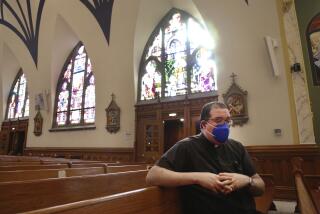Researchers Challenge Data on Churchgoing
- Share via
Think fast: How many Americans went to church last weekend? Forty percent? Twenty percent? Somewhere in between?
Whatever the guess, it might be right.
For years, some polling groups and sociologists who specialize in tracking the religious behavior of Americans have been at odds trying to get a handle on how many of us go to worship services on a regular basis.
Two of the best-known names in religion polling--the Gallup Organization and Barna Research Group--say about 4 in 10 Americans go to church weekly, a figure that has remained fairly consistent since 1939, when Gallup first began collecting such data.
But sociologists C. Kirk Hadaway, Penny Long Marler and Mark Chaves say in the February issue of the scholarly journal American Sociological Review that if actual heads were counted each weekend, just 20% of Americans would be found in church.
In “Overreporting Church Attendance in America: Evidence That Demands the Same Verdict,” the authors blame overreporting of church attendance by survey respondents as the primary reason for a major gap between their findings and the poll-based estimates.
“Most sociologists tended to think there was a little bit of a gap between what people said and what they did . . . but we didn’t see how large the gap was until we began [counting attendance] ourselves in 1992,” said Hadaway, a United Church of Christ official who has tracked church membership and attendance trends for 20 years.
“Our initial study, which was based on attendance counts of Protestants in one Ohio county and Catholics in 18 dioceses, indicated a much lower rate of religious participation than the polls report,” he said. “Instead of 40% of Protestants attending church, we found 20%. Instead of 50% of Catholics attending church, we found 28%.”
The sociologists counted people in pews and tallied cars in church parking lots, as well as attendance reports provided by pastors in Ashtabula County, Ohio, a region that has generally been found to be typical of churchgoing trends for the nation, Hadaway said.
David Kinnaman of the Barna Research Group remains confident in the 43% church attendance rate his organization came up with for 1998.
“We totally stand by our numbers,” he said.
But Hadaway said he and his colleagues believe that “too much trust has been placed in survey data and not enough attention given to membership records, patterns of giving, and even the incredulity of local church pastors when they hear that 40% of Americans attend church during an average week.”
Robert Woodberry, a sociologist at the University of North Carolina, Chapel Hill, who has studied churchgoing trends for three years, has reservations about the methodology used by Hadaway and his colleagues.
Woodberry’s estimate, however, is still considerably lower than Gallup’s or Barna’s.
His research indicates that the national churchgoing rate is about 29%.
Woodberry argues that “most polls oversample regular church attenders and so overrepresent their opinions.” Regular churchgoers are generally easier to contact at home, are more cooperative in answering surveys, and don’t mind telling pollsters about their religious activities, he said.
The basic question, Hadaway said, is: “How much trust should we put in what people say they do? Perhaps not as much as we have up to this point.”
He added: “Numerous studies show that Americans misreport voting, gifts to charities and illegal drug use. And their misreporting is in the expected direction: higher for voting and charity giving, lower for drug use.
“In terms of the real level of American church attendance, based on our total counts . . . I would say that American church attendance is somewhere around 21% to 22% at most,” he said.
More to Read
Sign up for Essential California
The most important California stories and recommendations in your inbox every morning.
You may occasionally receive promotional content from the Los Angeles Times.










